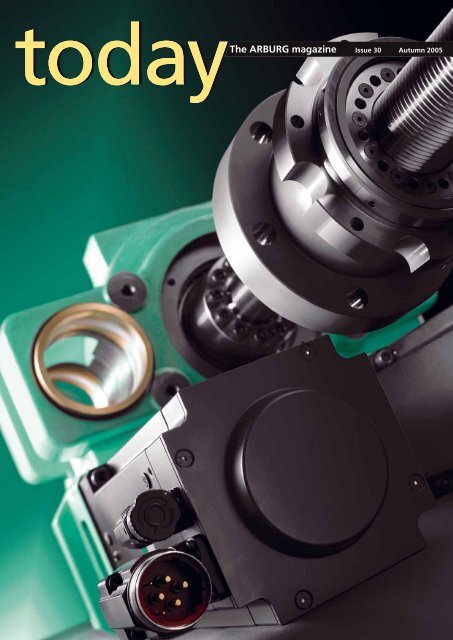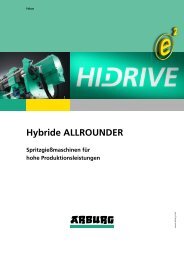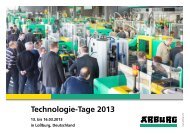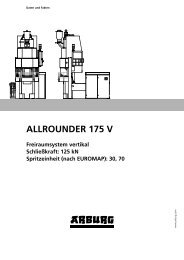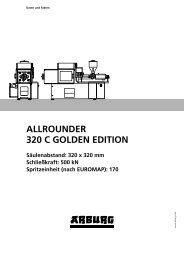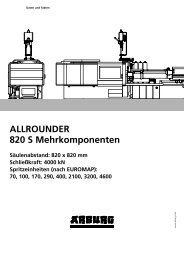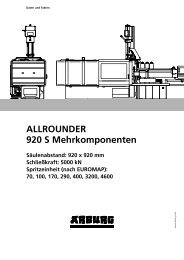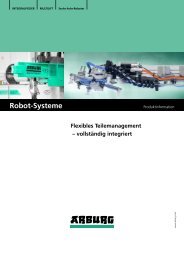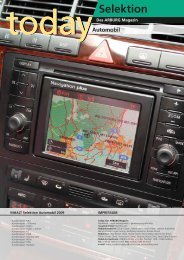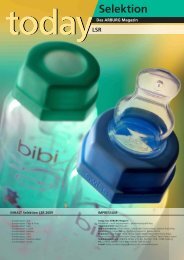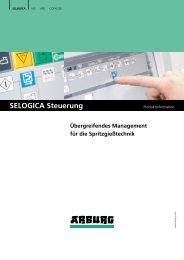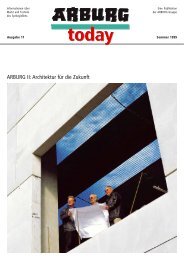GB - Arburg
GB - Arburg
GB - Arburg
Create successful ePaper yourself
Turn your PDF publications into a flip-book with our unique Google optimized e-Paper software.
today<br />
ARBURG magazine Issue 30 Autumn 2005<br />
todayThe
CONTENTS<br />
4<br />
6<br />
7<br />
8<br />
10<br />
12<br />
13<br />
14<br />
16<br />
18<br />
19<br />
Fakuma 2005<br />
Opening the curtain for the premiere<br />
Fakuma 2005<br />
Machine inspection and certifi cation<br />
Tips & tricks<br />
Everything under control?<br />
Customer report<br />
INOXCROM: Beautiful writing implements from Spain<br />
Project<br />
Endress+Hauser Conducta: Complete integration<br />
Exhibition<br />
Chinaplas in Guangzhou<br />
Event<br />
Five “Specialist” days<br />
Customer report<br />
Telegärtner Kunststofftechnik: Excellent process fl ow<br />
Product<br />
ALLDRIVE: All along the line<br />
History<br />
Milestones<br />
MASTHEAD<br />
Tech Talk<br />
Reduced cycle times on all electric machines<br />
today, the ARBURG magazine, edition 30, autumn 2005<br />
Reproduction – even in part – only by express permission<br />
Responsible: Dr. Christoph Schumacher<br />
Editorial Advisory Board: Juliane Hehl, Martin Hoyer, Bernd Schmid, Jürgen Schray,<br />
Wolfgang Umbrecht, Renate Würth<br />
Editorial team: Uwe Becker (text), Markus Mertmann (photos), Ralph Schreiber (text),<br />
Vesna Sertić (photos) Susanne Wurst (text), Peter Zipfel (layout)<br />
Editorial address: ARBURG GmbH + Co KG, PO box 1109, 72286 Lossburg,<br />
Tel.: +49 (0) 7446 33-3149, Fax: +49 (0) 7446 33-3413,<br />
e-mail: today_kundenmagazin@arburg.com, www.arburg.com<br />
2<br />
today 30/2005<br />
A glance at the internal workings of the electric<br />
ALLDRIVE: The electrically driven injection unit<br />
with planetary roller screw drive and electric<br />
dosing motor.
Dear readers,<br />
To begin with, I would like<br />
to say that it is a great pleas-<br />
ure for me to be introducing<br />
myself as one of the edito-<br />
rial writers contributing to<br />
our customer magazine, “today”. As managing direc-<br />
tor, I have been responsible for all sales activities in the<br />
ARBURG group since the start of the current year.<br />
Regular readers will know that the three managing part-<br />
ners and three managing directors of our company con-<br />
tribute alternately to this column, offering their views on<br />
business and technical issues related to ARBURG, as well<br />
as on topics which concern our entire industry.<br />
The highlight of the trade fair season this autumn will be<br />
the Fakuma in Friedrichshafen, Germany. At this trade<br />
fair, renowned throughout Europe and beyond for its<br />
appeal and charm, ARBURG will once again shine with<br />
world premieres of its new technology (pages 4-5). Our<br />
“ARBURG Expertise Centre” in Friedrichshafen will also<br />
demonstrate our intention to further expand our already<br />
wide range of customer-oriented services on a continuous<br />
basis. The “ARBURG Expertise Centre” has already man-<br />
aged to surprise even long-standing ARBURG customers<br />
during our Technology Days in April and our Specialist<br />
Days in June with the breadth of what it has to offer.<br />
Our reports on INOXCROM of Spain (pages 8-9) and<br />
Telegärtner Kunststofftechnik GmbH in Germany (pages<br />
14-15) demonstrate how our customers can enhance<br />
their success with know-how of this nature.<br />
We hope you enjoy reading<br />
our latest issue.<br />
today 30/2005 3<br />
Helmut Heinson<br />
EDITORIAL
Opening t<br />
Traditionally, ARBURG has always<br />
taken the stage at the<br />
Fakuma to make a major appearance.<br />
Though there may not be<br />
a gala event complete with evening<br />
wear, visitors will be infected with<br />
premiere fever at the 1,200 square<br />
metre, two-story ARBURG exhibition<br />
stand, where the new 470 U and 175 V<br />
ALLROUNDERs will be presented to<br />
the international trade public for the<br />
fi rst time. With the presentation of<br />
these two machines, ARBURG (which,<br />
incidentally, has been exhibiting at<br />
the Fakuma since it began in 1981)<br />
again highlights the signifi cance of<br />
this trade fair on the shores of Lake<br />
Constance for the international plastics<br />
industry.<br />
New introductions and additions to<br />
the U series have followed one<br />
after another in the last two<br />
years. Following the premiere<br />
of the ALLROUNDER<br />
170 U at the Fakuma 2003, the<br />
ALLROUNDER 270 U at the K<br />
2004 and the introduction of the<br />
ALLROUNDER 370 U this spring at<br />
the in-house Technology Days event,<br />
the new ALLROUNDER 470 U will<br />
now be presented. 470 U. With clamping<br />
forces of 800, 1000 and 1100 kN<br />
complemented with a choice of 170, 290<br />
and 400 series injection units, the new<br />
470 U is currently the largest machine in<br />
our “universal” series.<br />
In Friedrichshafen, the new<br />
ALLROUNDER 470 U with a clamping<br />
force of 1000 kN and a 400 series injection<br />
unit will be on view.<br />
Yet another world premiere at the<br />
Fakuma will feature the fully-hydraulic,
vertical ALLROUNDER 175 V. This vertical<br />
machine is the fi rst special machine, designed<br />
for encapsulating inserts, to be available as<br />
a standard model. The Allrounder 175 V<br />
is designed as a free-space system with<br />
an impressive degree of freedom around<br />
the mould. In addition, its small footprint<br />
means that it is ideal for integration<br />
into production processes. The Fakuma<br />
exhibition will feature the new vertical<br />
ALLROUNDER 175 V with a clamping force<br />
of 125 kN and the small 30 series injection<br />
unit.<br />
Even though the focus of visitor interest<br />
will be on the world premieres of<br />
the ALLROUNDER 470 U and the 175V,<br />
this does not mean that the seven other<br />
machine exhibits will be any less interesting.<br />
The all-electric A machine series<br />
will be represented by an ALLROUNDER<br />
320 A 600-170 with the LSR equipment<br />
package and an ALLROUNDER 420 A<br />
1000-400 which will be confi gured as a<br />
high-speed machine. An ALLROUNDER<br />
520 C 2000-800, featuring a wide range<br />
of peripherals and the newly-developed<br />
MULTILIFT V vertical robotic system, will<br />
be representing the C-series. This machine<br />
will produce an ABS handle for a hose. In<br />
addition to the new ALLROUNDER 470 U<br />
on display, the universal U-series will also<br />
be represented at the Fakuma by the small<br />
ALLROUNDER 170 U 150-30 and a 2-component<br />
version of the ALLROUNDER 370 U<br />
700-30/30, which will produce a planetary<br />
gear set for the company Oechsler<br />
using the micro-assembly injection moulding<br />
process. Representing ARBURG’s higher<br />
clamping force range, there will be an<br />
ALLROUNDER 820 S 4000-3200 confi gured<br />
as a fully-equipped accumulator machine<br />
along with an ALLROUNDER 630 S<br />
2500-1300/150 confi gured for a twocomponent<br />
application.<br />
Regardless of the achievements in machine<br />
technology on display, the focus of<br />
ARBURG’s presence at the trade fair will be<br />
its overall expertise in machine construction<br />
and the services it provides. The 2005<br />
Technology Days event saw the inauguration<br />
of the ARBURG Expertise Centre at<br />
the company’s headquarters at Lossburg.<br />
<strong>Arburg</strong>’s exhibit at the Fakuma includes a<br />
“stand-in-stand” concept where, in addition<br />
to the latest machine<br />
technology, visitors will fi nd<br />
the Expertise Centre, offering<br />
comprehensive know-how in<br />
consultancy.<br />
Our emphasis on service<br />
and customer benefi ts begin<br />
before the sale with the individual<br />
machine-requirements analysis and<br />
today 30/2005<br />
5<br />
FAKUMA 2005<br />
he curtain for the premiere<br />
extends seamlessly through to after-sales<br />
service provided by ARBURG experts. The<br />
following technology and service sectors<br />
will be presented at various consultancy<br />
areas in Friedrichshafen: multi-component<br />
technology, mould design, projects, elastomer,<br />
silicone and thermoset, training<br />
courses, Customer Service and International<br />
Technical Support (ITS), whose international<br />
services range from telephone support<br />
to customer visits and on-site training<br />
courses.<br />
The spacious exhibition stand thus<br />
conveys ARBURG’s comprehensive expertise<br />
as well as their natural focus on the<br />
benefi ts for each individual customer, in a<br />
variety of ways.<br />
The international plastics industry meets at the<br />
Fakuma in Friedrichshafen. The ARBURG exhibition<br />
stand in hall A3 is always a magnet for visitors.<br />
One of the highlights this year is a two-component<br />
version of the ALLROUNDER 370 U (below).
FAKUMA 2005<br />
Machine inspection<br />
In addition to the machine exhibits<br />
at the Fakuma, ARBURG will also<br />
be presenting its complete range<br />
of services at its stand-in-stand. The<br />
new inspection contracts, which include<br />
a certifi cate and an inspection<br />
stamp of approval, are the focus of<br />
our technical service. Thanks to the<br />
modular structure of the service, the<br />
inspection intervals and the scope of<br />
inspection can be determined individually<br />
according to the requirements<br />
of the customer.<br />
Because inspection plays an important<br />
role in many certifi cation processes,<br />
ARBURG has been offering its customers<br />
inspection contracts for a number of<br />
years now. As outlined in these contracts,<br />
ARBURG service technicians check all key<br />
elements of the machine for wear, correct<br />
function and safety at defi ned intervals.<br />
This also includes the inspection and, if<br />
necessary, recalibration of all machine and<br />
control parameters that relate to quality.<br />
In order to offer its customers tailormade<br />
solutions that meet a variety of<br />
quality standards, the new inspection contracts<br />
are designed in a modular format.<br />
The basic inspection includes the calibration<br />
of parameters relevant to the injection<br />
moulding process and can also include<br />
the recording of actual values as an<br />
option. Additional options include an evaluation<br />
of displacement measurements, an<br />
inspection of the mould platens for parallel<br />
alignment, with or without recording<br />
actual values in each case, testing the<br />
pressure inside the mould as well as the<br />
temperature measurement chain inside<br />
the cylinder and also in the mould, calibration<br />
of auxiliary control valves, a general<br />
inspection, a check of the protective<br />
guards and also an oil analysis by an independent<br />
laboratory. Approval tests can<br />
also be performed at the factory for new<br />
machines.<br />
These inspections can be performed<br />
in intervals of one or two years, depending<br />
on the requirements of the customer.<br />
The customer then receives updated<br />
digital documentation for each inspect-<br />
6 today 30/2005<br />
and certifi cation<br />
At the Fakuma 2003, the service<br />
department had its own presen -<br />
tation forum within the ARBURG<br />
stand (above). Among other items to be<br />
presented here in 2005 will be the new<br />
inspection contracts (right).<br />
ed machine, in which the results and<br />
measured values for up to fi ve inspections<br />
are logged and documented in detail.<br />
Within the scope of certification, for<br />
instance, this can serve as proof of preventive<br />
maintenance. In future, customers<br />
will also receive an offi cial ARBURG<br />
inspection certifi cate as well as inspection<br />
badges for each machine.<br />
In order to further illustrate the inspection<br />
process for visitors at the Fakuma,<br />
a service technician will explain the<br />
various inspections and measurements<br />
live on an ALLROUNDER 170 U.
When cooling water problems<br />
occur, the oil temperature<br />
increases, the shutdown<br />
threshold is reached and the<br />
machine performs an emergency stop.<br />
After that, the oil must cool down<br />
fi rst before production can resume.<br />
However, there is no need to reach<br />
that stage. Those who want to play<br />
it safe can equip their machine with a<br />
water distribution manifold, which is<br />
integrated into the SELOGICA control<br />
system and provides precise control<br />
over each of the individual cooling<br />
circuits.<br />
Depending on customer requirements,<br />
up to 15<br />
ALLROUNDER<br />
cooling water circuits<br />
can be adjusted<br />
manually or<br />
controlled automatically<br />
through<br />
integration into<br />
the SELOGICA<br />
control system.<br />
This kind of temperature<br />
control<br />
and monitoring<br />
offers a high level of production reliability<br />
and reproducibility. The various temperatures<br />
and their corresponding tolerances<br />
can be entered with little diffi culty using<br />
the SELOGICA user interface. In this way,<br />
the operator has all current temperatures<br />
in clear view during production and is notifi<br />
ed by an alarm when a temperature<br />
falls outside its tolerance range, allowing<br />
action to be taken before the machine<br />
switches off automatically.<br />
The temperature of the oil can be controlled<br />
using an oil cooler, which guarantees<br />
an optimum constant operating temperature<br />
of 45 °C. The tolerance is +/-10 °C,<br />
which ensures that the alarm is given well<br />
before the shut-down temperature of<br />
65°C is reached.<br />
Temperature control of the housing<br />
prevents the material from adhering<br />
around the feed zone. This temperature<br />
varies depending<br />
on the material<br />
being processed<br />
and can therefore<br />
be changed<br />
accordingly. On<br />
ALLROUNDERs<br />
with electro-mechanical<br />
dosage<br />
drives, the electric<br />
motor is temperature-stabilised<br />
to<br />
35 °C via a heat<br />
sink in the control cabinet. The cooling<br />
water circuits of water-cooled pump<br />
drive motors are also integrated into the<br />
SELOGICA system. Additional cooling<br />
today 30/2005<br />
water circuits are also available for cooling<br />
moulds and for external temperature<br />
control units, or for cooling the second<br />
housing or cylinder when processing LSR<br />
in multi-component injection moulding<br />
applications for example.<br />
Through their actuation by the<br />
SELOGICA control system interface, the<br />
relevant valves are opened automatically<br />
when the main switch, motor or mould<br />
heater are activated. This not only makes<br />
the ALLROUNDER easier to operate, but<br />
above all increases production reliability<br />
as well.<br />
7<br />
TIPS & TRICKS<br />
Everything under control?<br />
The integrated water distribution manifold<br />
(left) allows for the precise regulation of individual<br />
cooling water circuits via the SELOGICA<br />
user interface.
8 today 30/2005<br />
Even in the age of e-mail, text<br />
messaging and mobile phones,<br />
people continue to use pens<br />
for jotting down short notes, writing<br />
shopping lists, making sketches<br />
and taking telephone numbers. That<br />
pen may well be a product made by<br />
INOXCROM, Spanish manufacturers<br />
of writing implements. Producing approximately<br />
200 million metal and<br />
plastic writing implements each year,<br />
INOXCROM is one of the largest manufacturers<br />
of such items in the world,<br />
and they rely on ARBURG technology.<br />
Beautiful writing<br />
PHoto: A. Heinzelmann<br />
This international success story began<br />
in Barcelona in the year 1942 and continues<br />
to this day, when the company has an<br />
annual turnover of Euro 65 million as well<br />
as approximately 600 employees in Spain,<br />
France, Britain, Italy, Germany and the USA.<br />
INOXCROM is represented<br />
by its trading partners<br />
in a total of 72 countries,<br />
thus guaranteeing a tightly-woven<br />
sales network in<br />
the company’s chief markets,<br />
which are Europe<br />
and the USA.<br />
Company founder<br />
Manuel Vaqué created<br />
a robust yet attractive<br />
stainless steel pen – a<br />
fact which helps explain<br />
the origin of the name<br />
INOXCROM, as inox is a<br />
term referring to stainless steel. Thanks to<br />
strategic marketing and the highest technical<br />
standards, INOXCROM became one of<br />
the world’s largest companies specialising<br />
in individualised writing implements.<br />
Making up 65 percent of company sales,<br />
Photos: INOXROM
promotional items are the cash cow of this<br />
Spanish company. These items can be divided<br />
into the categories of mass giveaway<br />
items, higher-quality advertising gifts and<br />
exclusive presentation gifts. INOXCROM<br />
also produces its own product lines for direct<br />
sale via specialist shops, although this<br />
involves smaller margins. This includes highvalue,<br />
light hearted and youthful designs as<br />
well as designer product lines created in<br />
conjunction with well-known Spanish artists<br />
such as Ágatha Ruiz de la Prada, Jordi<br />
Labanda and the Kukuxumusu art label.<br />
INOXCROM’s aim of guaranteeing per-<br />
fect, long-lasting individualised printing on<br />
its writing implements requires ABS moulded<br />
parts of outstanding quality along with<br />
extremely high levels of printing expertise<br />
(screen printing and pad printing). Printing<br />
onto the individual parts of the pen is done<br />
before assembly in order to obtain the best<br />
possible printed image. INOXCROM’s specialties<br />
in this area lie in the photo realistic<br />
reproduction of images and the perfectlyaligned<br />
360° printing method.<br />
“If a colour exists, it can be reproduced”<br />
- a promise delivered by INOXCROM in<br />
impressive and wide-ranging fashion, as<br />
evidenced by its highly prominent array of<br />
international customers. The company has<br />
produced high-quality, aesthetically pleasing<br />
promotional items for customers such<br />
as McDonald’s, Strenesse, ZDF, Nestlé,<br />
Sony, Hewlett Packard, Puma, BMW, Levi’s,<br />
Vodafone and a number of other big players,<br />
each time creating items that are in<br />
perfect harmony with the corporate design<br />
of the respective customer. Of course,<br />
the internal workings meet the same high<br />
standards as the casings. Cartridges in the<br />
international Parker format with stainless<br />
steel tips and tungsten-carbide ball points<br />
allow for neat writing actions. The large-capacity<br />
cartridges guarantee a pen that can<br />
write for more than fi ve kilometres, which<br />
means that they last three times as long as<br />
a standard cartridge. Extraordinary in the<br />
industry: in addition to its writing implements,<br />
INOXCROM also produces its own<br />
cartridges. A comparatively high rate of inhouse<br />
production guarantees superior and<br />
above all consistent product quality while<br />
reducing dependence on suppliers. The<br />
excellent quality of INOXCROM products<br />
is based on the use of modern production<br />
implements from Spain<br />
methods and guaranteed by comprehensive<br />
quality management at the company’s<br />
central production facility in Barcelona. No<br />
product leaves the factory without passing<br />
stringent tests. What is more, scheduled<br />
production monitoring is made possible by<br />
the use of SAP. Production is carried out on<br />
a total of 62 injection moulding machines<br />
with clamping forces ranging from 150 to<br />
1,300 kN. In 1985, the fi rst ALLROUNDER<br />
was introduced into the machine fl eet. Now<br />
there are 35 ALLROUNDERs in the Barcelona<br />
plant, nearly all of them providing<br />
1,000 kN clamping force. Robust process<br />
quality through precision, reproducibility,<br />
reliability and uncomplicated maintenance<br />
are decisive arguments in favour of the<br />
ALLROUNDERs. High throughput with little<br />
downtime in two-shift mass production<br />
is an absolute must for this Spanish global<br />
market leader. The company has been<br />
thoroughly impressed with the quality of<br />
ARBURG machines. The specifi c production<br />
challenges that face the company arise<br />
today 30/2005<br />
from the wide range of colours offered, the<br />
high print quality required for promotional<br />
items and the short delivery times. All of<br />
these are process parameters which make<br />
it essential to have a reliable machine supplier.<br />
9<br />
CUSTOMER REPORT<br />
At the central production facility<br />
in Barcelona, 35 ALLROUNDERs<br />
produce writing implements of all kinds.<br />
INFOBOX<br />
Founded: 1942<br />
Employees: approximately 600 worldwide<br />
Products: writing implements<br />
Machine fl eet: 62 injection moulding<br />
machines, including 35 ALLROUNDERs<br />
with clamping forces of 150 to 1,300 kN<br />
Contact: INOXCROM, S.A.<br />
Torrent Estadella 46-54,<br />
08030 Barcelona, Spain<br />
www.inoxcrom.com
10 today 30/2005<br />
All<br />
With our all electric models,<br />
everything runs like a welloiled<br />
machine. This applies<br />
not only to the demand for the allelectric<br />
ALLDRIVE machines, but also<br />
to their production-line manufacture.<br />
The compatibility of the all-electric<br />
ALLROUNDERs with the hydraulic<br />
versions results in decisive advantages,<br />
not only with regard to manufacturing<br />
but also regarding the use<br />
of ALLDRIVE equipment at customer<br />
facilities.<br />
During the development of the allelectric<br />
ALLDRIVE machines, compatibility<br />
with hydraulic ALLROUNDERs took high<br />
priority. This involved performance, mechanical<br />
dimensions of the mould tool in<br />
relation to the distances between the tiebars<br />
or mould height the cylinder modules<br />
as well as the uniform operating system in<br />
the shape of the central SELOGICA control<br />
system. From the customer’s point of<br />
view, this meant that the electric machines<br />
should be able to accommodate existing<br />
moulds and cylinder module sizes, and<br />
that the operator will already be familiar<br />
with a control philosophy that is the same<br />
as that featured on the hydraulic machines.<br />
In addition, components used on<br />
both hydraulic and electric ALLROUNDER<br />
machines can also be series-produced in<br />
large quantities, in familiar ARBURG quality<br />
and at an optimum price-performance<br />
ratio. Moreover, these tried-and-tested<br />
components, including those such as the
along the line<br />
electro-mechanical dosage drive, have<br />
been proving their practical worth in<br />
everyday operation for many years now.<br />
MULTILIFT H robotic systems can also be<br />
used on ALLDRIVE machines with no diffi<br />
culty.<br />
Also, from an assembly point of view,<br />
our customers will benefi t from our years<br />
of experience with hydraulic machines<br />
and the ability to build the all-electric machines<br />
in currently two production lines.<br />
The machine base, clamping and injection<br />
units are built simultaneously and then assembled<br />
together. Additional components<br />
are added down the assembly line.<br />
The ALLDRIVE machine base incorporates<br />
not only a small hydraulic accumulator<br />
system (not included in the fully-electric<br />
version) but also an integrated temperature<br />
control unit with a closed cooling<br />
water circuit. This consists of an regulated<br />
cooling distributor which is supplied as a<br />
standard feature.<br />
The coolant in the closed cooling water<br />
circuit, water with anti-freeze and anticorrosive<br />
agents, is temperature-controlled<br />
via an internal heat exchanger, thus<br />
providing a constant temperature level for<br />
the electric drive motors and servo controllers<br />
for the three main axes, as well as the<br />
gearbox for the injection unit. By presetting<br />
a temperature between 35 and 40°C,<br />
the formation of condensation inside the<br />
motor can be eliminated. Furthermore,<br />
the closed system prevents any problems<br />
resulting from foreign particles entering<br />
the cooling water.<br />
The pre-assembly, commissioning and<br />
adjustment of the ALLDRIVE equipment<br />
requires specifi c know-how and great<br />
care, such as when assembling the gearbox<br />
for the injection unit, which itself<br />
contains a number of gear wheels. This is<br />
why the work must only be performed by<br />
persons specifi cally qualifi ed for ALLDRIVE<br />
servicing.<br />
During commissioning, precise adjustments<br />
are made to the machine which<br />
include the machine base, the clamping<br />
and the injection units. The platens are<br />
also measured and aligned so as to be<br />
perfectly parallel and on-centre. Force<br />
distribution is measured and adjusted via<br />
the four tie bars of the clamping unit using<br />
ring-type strain gauge sensors. The clamping<br />
and injection forces are determined<br />
using strain gauges and are then entered<br />
into the control system. Parameters for<br />
the motors and for communication with<br />
the frequency converters are set next and<br />
the closed gearbox system of the injection<br />
unit is fi lled with oil. The oil is fi ltered con-<br />
today 30/2005<br />
Assembly of the ALLDRIVE equipment calls for<br />
know-how and a great deal of care.<br />
The temperature control unit for the closed cooling<br />
circuit is integrated into the machine base of the<br />
ALLROUNDER A.<br />
11<br />
INFOBOX<br />
PRODUCTION<br />
tinuously during initial commissioning to<br />
ensure that no foreign particles are subsequently<br />
found in the closed system.<br />
Series: ALLROUNDER A (ALLDRIVE)<br />
Sizes: 320 A, 420 A, 520 A with<br />
clamping forces from 500 to 2,000 kN<br />
Design : modular drive technology:<br />
main axes with servo-electric drives<br />
(opening and closing the mould, injection,<br />
dosing), auxiliary axes (ejection,<br />
moving the nozzle, mould functions)<br />
with either electric or hydro-mechanical<br />
drives<br />
Technology: electrically-driven fi vepoint<br />
toggle system for high positional<br />
accuracy and rapid machine movements,<br />
small hydraulic accumulator for<br />
hydraulic movements<br />
Benefi ts: rapid simultaneous movements,<br />
low energy consumption, high<br />
precision, high reproducibility, low<br />
noise emissions
TRADE FAIR<br />
Chinaplas in Guangzhou<br />
The Middle Kingdom, explosive<br />
growth markets, the most populous<br />
economy in the world,<br />
the Great Wall: there are many clichés<br />
about China, and as is often the case<br />
with clichés, they are all correct to a<br />
certain extent, but they don’t really<br />
represent the whole picture.<br />
Yet the boom in the Chinese plastics<br />
market is no cliché. At Chinaplas,<br />
which was held for the very fi rst time<br />
in Guangzhou from 21-24 June, 2005,<br />
52,000 visitors had a chance to fi nd this<br />
out for themselves. In future, this trade fair<br />
will take place every two years in Shanghai<br />
and in the intervening years it will alternate<br />
between Peking and Guangzhou.<br />
Chinaplas is promoted by Hong Kongbased<br />
organiser Asdale in cooperation<br />
with Messe Düsseldorf, and is used by<br />
Photo: ADSALE Puplishing Ldt.<br />
ARBURG as a key focal point within the<br />
highly competitive Asian trade fair-market.<br />
This is why ARBURG used this venue<br />
to present two ALLROUNDERs in China<br />
for the fi rst time: the ALLROUNDER 420<br />
A, representing the all-electric ALLDRIVE<br />
series and also the universal, fully-hydraulic<br />
ALLROUNDER 270 U.<br />
It was a great success. “We were very<br />
satisfi ed with our exhibition at Chinaplas<br />
this year, and also with the response we<br />
received.” Helmut Heinson, Managing Director<br />
of Sales, attributed this positive summary<br />
of events in particular to the quality<br />
of the visitors and to the high amount of<br />
visitor traffi c at the ARBURG stand. One<br />
particular surprise was the large number<br />
of international, and especially European,<br />
customers who displayed a great deal of<br />
interest.<br />
“We want to bring some order to the<br />
ever-increasing number of regional and local<br />
trade fairs, to the benefi t of the larger<br />
fairs”, says sales manager Heinson while<br />
explaining the objective which is to become<br />
the focus of ARBURG, especially in<br />
the growing Asian and, in particular, Chinese<br />
markets. “With regard to these key<br />
aspects, we want to get even more involved<br />
in future at a level that is in line with<br />
our global signifi cance,” said Heinson, laying<br />
out the company’s course. “Our global<br />
strategy is clear. Large key markets require<br />
us to maintain a prominent presence,” said<br />
12 today 30/2005<br />
Photos: G. Ziegler<br />
Heinson, emphasising ARBURG’s intention<br />
by offering its well-known and highly regarded<br />
standards of after-sales service in<br />
the Chinese market.<br />
And if the Chinese market continues to<br />
grow, this strategy leaves ARBURG with<br />
every opportunity to pursue further expansion.<br />
As we all know, at ARBURG that<br />
is not just a cliché...<br />
Considerable interest in ARBURG: even<br />
Chen Shi-neng (3rd from left), high-ranking member<br />
of the National People’s Congress and president of<br />
the China National Light Industry Council, and Liao<br />
Zheng-pin (right), president of the China Plastics<br />
Processing Industry Association (CPPIA), visited<br />
Managing Director Helmut Heinson (2nd from left)<br />
at the ARBURG stand.
Five “Specialist” days<br />
Even in the area of injection<br />
moulding there are special applications,<br />
as could be seen at<br />
ARBURG over a period of fi ve days<br />
from 13-17 June. At a one-day presentation<br />
held during the ARBURG Specialist<br />
Days event, approximately 370<br />
delegates from 13 countries were on<br />
hand to fi nd out more on the topic of<br />
“machine concepts for the processing<br />
of cross-linking materials”.<br />
Production requirements for thermoset,<br />
silicone and elastomer processors formed<br />
the central focus of the event. Running on<br />
a total of 13 machine exhibits, special applications<br />
were presented and explained in<br />
detail with particular references to material,<br />
moulded part weight, cycle time and<br />
machine accessories with the aid of indepth<br />
process recommendations.<br />
Many visitors were amazed that no<br />
special machines were used for the special<br />
applications demonstrated, but that<br />
only application-specifi c modifi cations to<br />
proven ARBURG ALLROUNDER technology<br />
enabled reliable production with all<br />
the different processes.<br />
The range of applications on display<br />
was quite diverse:<br />
On an ALLROUNDER 370 C, a belt pulley<br />
with a part weight of 90 grams was<br />
produced from pourable thermoset. An<br />
ALLROUNDER 570 C was used to produce<br />
an insulating rail from moist polyester<br />
with a part weight of 295 grams<br />
in a cycle time of 80 seconds. On an<br />
ALLROUNDER 420 A, an infl atable seal<br />
with a part weight of 10 grams was injection<br />
moulded using LSR in a cycle time of<br />
40 seconds. In addition, there were<br />
three two-component applications<br />
for processing thermoplastic and<br />
LSR. A sample elastomer application<br />
was provided by an Allrounder<br />
420 C, which produced a damper<br />
with a part weight of 1.2 grams from<br />
EPDM or optionally NBR.<br />
Also particularly impressive was the<br />
powder injection moulding of a knife<br />
blade with a part weight of 7.55 grams on<br />
an Allrounder 320 C and the production<br />
of a table tennis bat as a multi-component<br />
application from ABS and TPE on an<br />
Allrounder 630 S.<br />
The big advantage of the Specialist<br />
Days: this special event represents an<br />
ideal supplement to the thematically more<br />
comprehensive Technology Days, which<br />
attracted large numbers of visitors to<br />
ARBURG in April this year.<br />
today 30/2005<br />
13<br />
EVENT<br />
Using a variety of applications, ARBURG<br />
presented the processing of thermoset,<br />
elastomer and LSR on its ALLROUNDERs,<br />
also as a two-component process combined<br />
with a thermoplastic.
Excellent process<br />
Creatingadded<br />
value through reduction:<br />
Telegärtner Kunststofftechnik<br />
GmbH was able to do just that by<br />
combining various process steps in<br />
the production of a four-way valve<br />
for medical applications. For the innovative<br />
redesign of this moulded<br />
part, which had been previously produced<br />
in several production steps, the<br />
company, which belongs to the international<br />
Telegärtner Group, was presented<br />
with the TOP 100 innovation<br />
prize.<br />
Founded in 1973 as Teleplast Beyer und<br />
Gärtner GmbH with fi ve employees, the<br />
company quickly grew beyond its origins in<br />
the production of electronic and communications<br />
technology. Reducing dependence<br />
on particular industries by focussing<br />
on process technology solutions is<br />
the successful business model which<br />
allowed Telegärtner to achieve turnover<br />
of Euro 4 million in 2004. Along<br />
with sales growth, the need for additional<br />
space grew as a consequence. In 2004,<br />
the company moved into new offi ces.<br />
Based in Steinenbronn, Germany, not<br />
far from Stuttgart, and with 35 employees,<br />
the company has been serving customers<br />
from the medical technology<br />
and biotechnology industries, the<br />
automotive sector and also the<br />
pharmaceuticals and cosmetics<br />
industries for a<br />
number of years. Germany<br />
and Europe are<br />
the main sales markets<br />
f o r Telegärtner’s products,<br />
w hich are made exclusively from<br />
thermoplastic and ceramics.<br />
Special processes are nothing out of<br />
the ordinary at Telegärtner: multi-component<br />
injection moulding, in-mould<br />
assembling, in-mould decorating (IMD)<br />
and in-mould labelling (IML), ceramic injection<br />
moulding, clean room technology<br />
and ultrasound welding are a matter of<br />
course. In addition to its special processes,<br />
Telegärtner’s special expertise in processing<br />
complex material combinations is the<br />
major plus point of this German awardwinner<br />
for innovation.<br />
Of course, this expertise is also offi cially<br />
certifi ed: Telegärtner is ISO 9001:2000<br />
14 today 30/2005<br />
and also TS 16945 certifi ed and will also<br />
be receiving the ISO 13485 certifi cation in<br />
the near future.<br />
Let us go back to the award-winning<br />
four-way valve: this part, conventionally<br />
produced using individual components<br />
which were later assembled, is now produced<br />
in one process step which inludes<br />
the assembly of the individual components.<br />
Here, in an 8+8+8 impression hotrunner<br />
mould with integrated handling,<br />
three-component injection moulding and<br />
in-mould assembly are brought together.<br />
Thanks to optimisation, this patented<br />
process enables a sizeable reduction in<br />
costs while at the same time achieving an<br />
improved and safer function. The requirements<br />
are strict: the casing, union nut and<br />
plug (the movable inner part of the valve)<br />
all come into contact with the liquid medium.<br />
It must be possible to turn the plug,<br />
yet at the same time the plug must form a<br />
tight seal. The casing, union nut and plug
fl ow<br />
are parallel injected using two materials,<br />
transferred in the mould and encapsulated<br />
with a third component which gives the<br />
part its colour. With the optimised process,<br />
Telegärtner was now able to produce<br />
parts for other industries. This innovative<br />
process made it possible to reduce the<br />
production costs of a sunlight sensor for a<br />
motor vehicle by 60 percent.<br />
Ideas make all the difference and lead<br />
to new beginnings. “Ideas, design, process,<br />
product”: these are the steps Telegärtner<br />
employs for its process technology solutions<br />
while always keeping an eye out<br />
for process cost reduction and production<br />
optimisation.<br />
ARBURG has been a reliable partner<br />
of Telegärtner since 1973, a fact that<br />
Telegärtner’s Managing Director Frank<br />
Heinzelmann again emphasised during his<br />
last visit to ARBURG headquarters in Lossburg,<br />
where he was very appreciative of<br />
the cooperative relationship between the<br />
two companies.<br />
The more than 30 ALLROUNDERs found<br />
at Telegärtner are by no means there by<br />
chance, rather their presence is the result<br />
of systematic expansion efforts as well<br />
as an excellent business relationship dating<br />
back over three decades. This is why<br />
ARBURG machines make up the bulk of<br />
the machine fl eet in clamping forces ranging<br />
from 250 to 1,200 kN. The machines<br />
operate in three shifts. Seven of these are<br />
used as two-component machines. Minimal<br />
downtime, optimal reproducibility<br />
and superior precision are the primary requirements<br />
which the ALLROUNDERs fulfi<br />
l. Telegärtner’s decision to produce their<br />
award-winning, highly complex four-way<br />
valve on ALLROUNDER machines is a sure<br />
sign of the company’s faith in ARBURG<br />
technology.<br />
today 30/2005<br />
15<br />
In Steinenbronn, various products including medical<br />
components are produced on ALLROUNDER<br />
machines. During his visit to Lossburg, Managing<br />
Director Frank Heinzelmann met Juliane Hehl, one<br />
of the Managing Partners at ARBURG.<br />
INFOBOX<br />
CUSTOMER REPORT<br />
Founded: 1973<br />
Employees: 35<br />
Industries: Medical technology,<br />
biotechnology, automotive, pharmaceuticals<br />
and cosmetics, electrical and<br />
communications technology<br />
Sales: Euro 4 million in 2004<br />
Contact:<br />
Telegärtner Kunststofftechnik GmbH<br />
Gewerbestr. 4-6, 71144 Steinenbronn<br />
www.tg-kunststofftechnik.com
Endress+Hauser Conducta,<br />
Gesellschaft für<br />
Mess- und Regeltechnik<br />
mbH+Co.KG, is one of the leading<br />
companies in the world specialising<br />
in analytical and sensor equipment<br />
for the environmental and process industries.<br />
Their systematic strategy for<br />
growth is based on constant technological<br />
innovation and the optimisation<br />
of internal processes, which also<br />
includes the increased automation of<br />
production. For their latest product,<br />
an inductive sensor for conductivity<br />
measurement, the company has<br />
invested in a production cell based<br />
around an ALLROUNDER 420 C with<br />
an extensive array of peripheral equipment<br />
which is completely integrated<br />
into the machine control system.<br />
The product range of Endress+Hauser<br />
Conducta includes sensors and self-contained<br />
systems for determining pH-value,<br />
conductivity, oxygen and chlorine<br />
content, turbidity and solids content,<br />
ammonia, nitrate and phosphate content<br />
as well as that of other chemical<br />
substances. The company’s products are<br />
used in various processing industries.<br />
With an extraordinarily high level<br />
of R & D together with a great deal of<br />
vertical integration, the company offers<br />
its customers the latest technologies<br />
and therefore a high degree of quality,<br />
performance, safety and effi ciency.<br />
A large number of<br />
awards for innovation<br />
testify to the leading<br />
technological position<br />
of Endress+Hauser Conducta.<br />
One of the newest products is the Indumax<br />
H CLS54, a sensor for the inductive<br />
measurement of fl uid conductivity<br />
to be used in the foodstuffs and beverage<br />
industry which will be released in<br />
Autumn 2005. This sensor is available in<br />
two different entry depths (lengths) and<br />
in a total of 34 different<br />
versions, which vary in<br />
terms of materials and<br />
connection to the process.<br />
The demands placed<br />
on the sensor are high:<br />
direct contact with aggressive<br />
solvents, temperatures<br />
from -10 °C<br />
to +120 °C, pressures of<br />
up to 12 bar at 20 °C, up<br />
to 8 bar at 120 °C and<br />
vacuums down to 0.1<br />
bar absolute pressure.<br />
For sterilisation, temperatures<br />
of up to 150 °C and pressures of<br />
up to 5 bar are reached for a period of<br />
60 minutes. For this reason, the sensor is<br />
completely encapsulated with PEEK. This<br />
material features good chemical and<br />
thermal resistance characteristics and it<br />
fulfi ls hygiene and cleaning requirements<br />
16 today 30/2005<br />
Complete<br />
due to its smooth surface. To meet these<br />
requirements, the sprue section which<br />
forms during injection moulding must<br />
also be subsequently milled over.<br />
The Indumax H CLS54 is manufactured<br />
on a system centred around an<br />
ALLROUNDER 420 C 100-350, for which<br />
there is a single-cavity mould available<br />
for each entry depth. Additional components<br />
that form the production cell<br />
are a MULTILIFT V robotic system with<br />
special gripper, a rotary table with two<br />
work-piece carriers for 48 inserts each,<br />
a pre-heating oven, a<br />
milling station as well as<br />
a conveyor belt system<br />
with trays for the fi nished<br />
product. Thanks to<br />
the full integration of the<br />
peripheral equipment<br />
(robotic system, rotary<br />
table, pre-heating oven<br />
and milling station) into<br />
the SELOGICA machine<br />
control system, the individual<br />
process steps are<br />
coordinated with one<br />
another in an optimum<br />
sequence.<br />
The overall production sequence begins<br />
with the loading of the outer rotary<br />
table station. At the same time the inserts<br />
are picked up from the inner station by<br />
the MULTILIFT V and deposited into the<br />
pre-heating oven. From there, the robotic<br />
system removes the pre-heated parts
integration<br />
and places them into the hot runner<br />
mould, which is temperature-stabilised<br />
to 200 °C. After the injection moulding<br />
stage, the sprue picker integrated in the<br />
handling system fi rst removes the sprue<br />
before the encapsulated part is picked<br />
up and deposited into the milling station<br />
for fi nishing. The shavings are vacuumed<br />
out immediately while the sprue section<br />
is being milled. In the last step, the fi nished<br />
product is laid in the trays of the<br />
palletising system.<br />
In the entire production process for<br />
the Indumax H CLS54, of which 6,000 -<br />
7,000 pieces are to be produced annually<br />
in future, around 60 percent of the added<br />
value is attributable to the ARBURG production<br />
cell. Due to the large number of<br />
different versions, reconfi guration is frequent,<br />
which is where the ARBURG rapid<br />
clamping system comes into play. Also<br />
benefi cial are the separate data entries for<br />
individual versions, which can be quickly<br />
entered into the SELOGICA control system<br />
during reconfi guration.<br />
“One key consideration in our decision<br />
to purchase an ARBURG production<br />
cell was the ability to completely<br />
integrate all of the peripherals into the<br />
central SELOGICA control system. Another<br />
was the reliable performance of<br />
our ’old’ ALLROUNDER, which we have<br />
been using for around 15 years to produce<br />
high-quality, technologically sophisticated<br />
items.” says Andreas Siedler,<br />
project head in the Research and Development<br />
department at the headquarters<br />
of Endress+Hauser Conducta in Gerlingen<br />
near Stuttgart. Also important for<br />
Mr. Siedler is the ability to keep a constant<br />
eye on the plant, which is located<br />
nearly 500 km away in Waldheim (in the<br />
German region of Saxony) as well as the<br />
ability to access machine and production<br />
data immediately when necessary. For<br />
these reasons, the machine also has the<br />
optional ARBURG Remote Service (ARS)<br />
and the ALLROUNDER@web machine<br />
interface, which allow production data,<br />
screen pages and data records to be accessed<br />
remotely via the internet.<br />
today 30/2005<br />
17<br />
PROJECT<br />
The MULTILIFT V performs all handling operations<br />
(top right): the insert (top left) is picked<br />
up, deposited into the pre-heating oven and<br />
inserted into the mould, the moulded part is<br />
removed, deposited onto the milling station<br />
(centre right) and fi nally, the fi nished part<br />
(centre left) is set down.<br />
INFOBOX<br />
Founded: 1970 in Stammheim,<br />
Germany, part of Endress+Hauser<br />
Group since 1977<br />
Employees: over 400 worldwide<br />
(2004)<br />
Production facilities: Waldheim<br />
(Saxony, Germany) and Anaheim<br />
(California, USA)<br />
Products: sensors and self-contained<br />
systems for determining pH-value, conductivity,<br />
oxygen and chlorine content,<br />
turbidity and solids content, ammonia,<br />
nitrate and phosphate content as well<br />
as that of other chemical substances<br />
Customers: processing industries<br />
such as chemicals and petrochemicals,<br />
pharmaceuticals, foodstuffs, water and<br />
sewage, paper and energy<br />
Contact: Endress+Hauser Conducta<br />
GmbH+Co.KG, Dieselstraße 24,<br />
70839 Gerlingen, Germany,<br />
www.conducta.endress.com
HISTORY<br />
MILESTONES<br />
The Biamat sliding table (above)<br />
was a forerunner of the modern<br />
ALLROUNDER T rotary table machines<br />
(below).<br />
With all of the development<br />
milestones established<br />
by ARBURG in the past 50<br />
years, the benefi t to customers of our<br />
products has always been the driving<br />
force behind our innovations. Practical<br />
usefulness, simple operation and<br />
economical manufacturing in particular,<br />
have always been key objectives<br />
for us. A perfect example of this is the<br />
Biamat sliding table. First introduced<br />
in 1975, this was a forerunner, so to<br />
speak, of the modern rotary table machines.<br />
In essence, the Biamat was a peripheral<br />
device which could only be used in conjunction<br />
with an injection moulding machine,<br />
in this case the ALLROUNDER 221,<br />
for the purpose of encapsulating inserts.<br />
Although it was possible to retrofi t a machine<br />
with the Biamat, doing so was a very<br />
costly and lengthy process. When used<br />
with the Biamat, the machine maintained<br />
its manufacturing fl exibility. Processing<br />
could be carried out with both horizontally<br />
and vertically arranged injection<br />
units.<br />
The Biamat’s method of operation<br />
was simple, yet effective. Initially<br />
pneumatically operated, and<br />
later available with hydraulic operation,<br />
the sliding table was attached to the<br />
clamping unit of the machine. One of the<br />
two movable mould halves would fi rst be<br />
loaded with inserts and moved into the<br />
clamping unit for encapsulation. At the<br />
same time, the second mould half could<br />
be loaded at an adjacent loading station.<br />
On completion of the fi rst encapsulation<br />
process the mould half would retract from<br />
the clamping unit and then slide to the va-<br />
18 today 30/2005<br />
cant station which could either be on the<br />
left or right-side loading position. There,<br />
the fi nished parts would be removed and<br />
the mould half could be reloaded. Similarly<br />
the second movable mould half would<br />
have moved in and out of the clamping<br />
unit to the other loading station. Here, the<br />
fi nished parts would again be removed<br />
and then new inserts loaded, whilst new<br />
parts were already being encapsulated on<br />
the fi rst half of the mould. Though the<br />
description may sound complicated it is<br />
nothing more than moving each mould<br />
half forward in and out of the clamping<br />
unit and sideways left and right for the unloading<br />
and reloading operations.<br />
The most important advantage of the<br />
Biamat was the separation of the insertion<br />
and encapsulation processes, which resulted<br />
in a much faster production sequence.<br />
The ALLROUNDER T rotary table machines<br />
later made use of the same principle, although<br />
this featured a rotary transfer table<br />
instead of a sliding table.<br />
Even today, our ALLROUNDER T machines<br />
still use the rotary table principle<br />
which, in association with a down stroking<br />
clamping unit, rotates either 180° in<br />
a forwards and backward movement (two<br />
stations) or by 120° clockwise movement<br />
(three stations). With the latter version, it is<br />
possible to automatically load and remove<br />
encapsulated parts which can also be realised<br />
with the two-component process. As<br />
with all today’s ALLROUNDER rotary table<br />
machines, fully automatic part production<br />
can be carried out which is completely integrated<br />
into the SELOGICA system.
TECH TALK<br />
Reduced cycle times on all electric machines<br />
In addition to energy consumption,<br />
cycle time and fast machine<br />
movements are the main arguments<br />
nowadays in favour of all electric<br />
injection moulding machines. On<br />
ALLDRIVE machines, the reduction<br />
in cycle time is the result of the combined<br />
speed-optimised toggle and independent<br />
electric drive axis.<br />
The electrically driven fi ve-point toggle<br />
system of the ALLDRIVE has been specially<br />
confi gured for the dynamic behaviour of<br />
the electric drive, allowing for rapid, highly<br />
accurate movements resulting in the reduction<br />
of the cycle time. Due to the functional<br />
principle of the toggle, it is possible<br />
to dispose with the pressure build-up time<br />
which is necessary in the case of hydraulic<br />
With the so-called “pile driver”,<br />
the Dutch equivalent<br />
of a foundation stone-laying<br />
ceremony, construction of the<br />
new building in Utrecht for ARBURG‚s<br />
Dutch subsidiary was initiated last<br />
May.<br />
The fi rst pile, a 13.6-metre fi r from the<br />
Lossburg forest, was driven into the sandy<br />
ground by Michael Hehl, spokesperson for<br />
the management team. In his function as<br />
head of the plant development division,<br />
he travelled to Utrecht accompanied by<br />
his father, Eugen Hehl and the ARBURG<br />
architect, Manfred Wolfer, in order to<br />
jointly celebrate the start of construction<br />
work with the manager of the subsidiary,<br />
mould clamping to compress the oil during<br />
the build-up of clamping pressure.<br />
Thanks to their independent operation,<br />
in conjunction with the fl exible programming<br />
and control possibilities of the<br />
SELOGICA system, the ALLDRIVE electric<br />
axis drives offer greater potential for optimising<br />
the reduction of cycle times.<br />
The separation of the plasticising procedure<br />
from the cooling time can also contribute<br />
to a reduction in cycle time. For applications<br />
in which the cooling time alone<br />
is insuffi cient for dosing and therefore the<br />
dosing time dictates the cycle time, it is<br />
possible to perform dosing beyond the<br />
cooling time via an independent electric<br />
dosing drive without increasing the cycle<br />
time. However, in this case it is necessary<br />
to use a shut off nozzle. The cycle time<br />
A “pile driver ceremony”<br />
Carlo Brouwer, his team<br />
of employees and the<br />
Dutch planners.<br />
The original wooden<br />
pile from Lossburg will<br />
be visible through a<br />
glass fl oor panel in the<br />
lobby area after completion<br />
of the building. The<br />
new L-shaped building<br />
will span an area of approximately<br />
one thousand square metres,<br />
offering suffi cient space for the Sales,<br />
Service, Spare Parts and Training departments.<br />
today 30/2005 19<br />
TECH TALK<br />
Jürgen Schray, Depart. Manager, Applications Technology<br />
between the mould movements can be<br />
shortened with the use an electric ejector,<br />
which ejects parts precisely and dynamically.<br />
The utilisation of the potential offered<br />
by electric drives, however, is dependent<br />
on its support from the relevant moulding<br />
technology. For instance, it is also highly<br />
important that moulds are able to support<br />
the faster cycles particularly when considering<br />
the use of cores and controlling the<br />
mould temperature.<br />
Photo: Jan de Kruif<br />
Michael Hehl took over the controls of the<br />
special pile-driving machine and rammed the<br />
13.6 metre long wooden pile into the ground.
Universal<br />
Today, you need to adapt quickly to ever-<br />
changing market demands. At least you have to<br />
react quicker than the competition. Get ahead<br />
of the competition with the universal hydraulic<br />
ALLROUNDER U series: ranging from the 170 U for<br />
ARBURG GmbH + Co KG<br />
Postfach 11 09 · 72286 Lossburg<br />
Tel.: +49 (0) 74 46 33-0<br />
Fax: +49 (0) 74 46 33 33 65<br />
e-mail: contact@arburg.com<br />
micro-components of just a few hundredths of a<br />
gram, to the 470 U with a maximum moulded part<br />
weight of 232 g, our machines offer economical<br />
operation, modularity, fl exibility and adaptability.<br />
Universally active - with ARBURG.<br />
www.arburg.com


